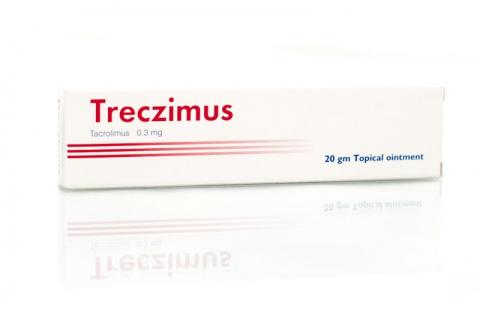Brand Name: Treczimus 0.03% topical Ointment
Active Ingredient: Tacrolimus Monohydrate
When is Treczimus ointment prescribed for?
Treczimus 0.03 % ointment is indicated in adults, adolescents & children from the age of 2 years.
Flare treatment
Adults and adolescents (16 years of age and above)
Treatment of moderate to severe atopic dermatitis in adults who are not adequately responsive to or are intolerant of conventional therapies such as topical corticosteroids
Children (2 years of age and above)
Treatment of moderate to severe atopic dermatitis in children who failed to respond adequately to conventional therapies such as topical corticosteroids
Maintenance treatment
Treatment of moderate to severe atopic dermatitis for the prevention of flares and the prolongation of flare-free intervals in patients experiencing a high frequency of disease exacerbations (i.e. occurring 4 or more times per year) who have had an initial response to a maximum of 6 weeks treatment of twice daily tacrolimus ointment (lesions cleared, almost cleared or mildly affected).
How should you take Treczimus ointment?
Treczimus ointment should be applied as a thin layer to affected or commonly affected areas of the skin.
Treczimus ointment may be used on any part of the body, including face, neck and flexure areas, except on mucous membranes.
Treczimus ointment should not be applied under occlusion because this method of administration has not been studied in patients
When you should not take Treczimus ointment?
Hypersensitivity to the active substance, macrolides in general, or to any of the excipients
Possible Drug interaction with Treczimus ointment:
Interactions with other medicinal products and other forms of interaction Formal topical drug interaction studies with tacrolimus ointment have not been conducted.
Tacrolimus is not metabolized in human skin, indicating that there is no potential for percutaneous interactions that could affect the metabolism of tacrolimus.
Special Warning and Precaution when using Treczimus ointment:
Long term safety of topical calcineurin inhibitors has not been established although a causal relationship has not been established , rare cases of malignancy e.g. skin and lymphoma ) have been reported in patients treated with topical calcineurin inhibitors ,therefore :
- Continuous long term use of topical calcineurin inhibitors , in any age group should be avoided , and application limited to areas of involvement with a topic dermatitis
- Not indicated for use in children less than 2 years of age
- Not first line use
Treczimus should not be used in patients with congenital or acquired immune-deficiencies or in patients on therapy that cause immunosuppression.
Special information if you are pregnant or breastfeeding.
Pregnancy
There are no adequate data from the use of tacrolimus ointment in pregnant women. Studies in animals have shown reproductive toxicity following systemic administration. The potential risk for humans is unknown.
Treczimus ointment should not be used during pregnancy unless clearly necessary.
Breastfeeding
Human data demonstrate that, after systemic administration, tacrolimus is excreted into breast milk. Although clinical data have shown that systemic exposure from application of tacrolimus ointment is low, breast-feeding during treatment with Treczimus ointment is not recommended
Possible Side Effects of Treczimus ointment
In clinical studies approximately 50% of patients experienced some type of skin irritation adverse reaction at the site of application. Burning sensation and pruritus were very common, usually mild to moderate in severity and tended to resolve within one week of starting treatment. Erythema was a common skin irritation adverse reaction. Sensation of warmth, pain, paraesthesia and rash at the site of application were also commonly observed. Alcohol intolerance (facial flushing or skin irritation after consumption of an alcoholic beverage) was common.
Patients may be at an increased risk of folliculitis, acne and herpes viral infections.

